Tweeks: Review Riverdale
Maddy & Anya review the first two episodes of The CW’s new teen drama Riverdale comparing it to the comics.
Maddy & Anya review the first two episodes of The CW’s new teen drama Riverdale comparing it to the comics.
Here’s the plan. You’ll wait until the office is closed for the day and the lights are all out and then, possibly wearing a tool belt, you’ll sneak inside and remove the appliance from its place near the big chair and take it home and put it on the couch and sit next to it. Then you’ll tune in NBC’s new comedy, Powerless. (Did I mention that this will be on Thursday night?) You’ll turn on the laughing gas machine, the one that belongs to your dentist and place the mask over your nose and mouth. This is necessary, according to you, because you might not find the show funny and yet it’s supposed to make you laugh and if it doesn’t you’ll feel frustrated and to avoid this ugly feeling you can sniff the laughing gas and have yourself a good chuckle and maybe a gas-induced laugh is better than none at all.
Enough of that.
I know very little about Powerless, not much more than it’s about an insurance company that deals with the collateral damage that would inevitably accompany the damage superheroes cause while doing their superstuff. Not the worst premise I’ve ever encountered.
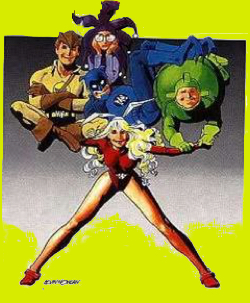 This is not new, this conflation of humor with superheroics.
This is not new, this conflation of humor with superheroics.
A few weeks back, I mentioned Herbie the Fat Fury, who appeared in the American Comics Group titles, and Hoppy the Marvel Bunny, part of the Captain Marvel posse, and The Inferior Five which, if memory serves, was about a quintet of costumed goofballs who did superheroish feats of the goofball variety. And on television there were Captain Nice and Mr. Terrific, whose live action adventures may have been inspired by Batman.
Ah, Batman. Saving the best for last, were we? Batman, of course, was a comic book crusader for years before he made his way to the tube. He had also appeared in two movie serials, in newspapers, and as an occasional guest star on the Superman radio series. So it was probably no great surprise that he’d pop into your living room sooner or later. But how he popped – that may have qualified as a surprise. This Batman was not merely a dark clad vigilante who prowled the city ever seeking to avenge his parents’ murder by assaulting crime wherever it was found – he was a dark-clad comedian who assaulted crime. Yep. Funny ha-ha kind of dude.
I won’t burden you with my opinions on how Batman’s comedy was achieved. Let’s just agree that is was achieved, for a while quite successfully. Then public taste moved on, leaving Batman to a protracted afterlife in rerun city. Quirky thing: Adults coming to the show for the first time tend to see it as what is was intended to be: funny. Kids, though, are more likely to enjoy it as action-adventure. I await explanations but not, I confess, on tenterhooks.
Meanwhile, we have a new show to sample.
Maybe we’re lucky.
A lot of people have been bitching and moaning about our latest president. Some think he’s an impulsive idiot. Others, a dangerous megalomaniacal narcissist with a remarkably selective and astonishingly petty memory. Still others find him a dangerous man who is likely to destroy the American Dream and, quite possibly, America.
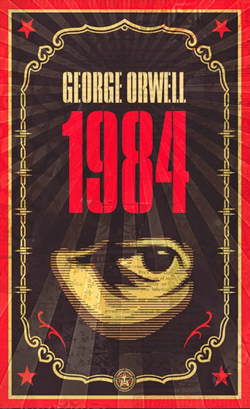 Even though I believe all of that may be true, I have this to say about Donald J. Trump: he has gotten Americans to pick up and read a book or two. And that includes graphic novels.
Even though I believe all of that may be true, I have this to say about Donald J. Trump: he has gotten Americans to pick up and read a book or two. And that includes graphic novels.
It has been well-reported that, after he reamed out Congressman John Lewis by falsely accusing him of not helping “his district, which is in horrible shape and falling apart, not to mention crime infested,” sales of Congressman Lewis’s autobiographical three-book graphic novel series March went through the roof. Amazon actually sold out, something I thought was nigh onto impossible.
A week later – and the man’s only been in office for 20 days, total – his anointed spokesliar Kellyanne Conway said, in response to Trump’s claim that three to five million people attended his inauguration, that media reports of at best one million were lies and they (Team Trump) had the “alternate facts.”
Alternative facts, you say?
Two things happened almost immediately. First, people learned they could be completely frightened yet laugh hysterically at the same time. Second, they ran out (to their computers, smartphones, and cars) and purchased copies of George Orwell’s dystopian classic 1984.
For those who have yet to indulge in this science fiction classic – and, really, you should – 1984 is the novel that gave us such phrases and philosophies as “war is peace,” “freedom is slavery,” “ignorance is strength,” “it’s a beautiful thing, the destruction of words,” and “if thought corrupts language, language can also corrupt thought.”
According to Publishers’ Weekly, “Print sales of the Signet Classics edition of 1984 for the week ended January 29 were almost 26,000 copies at outlets that report to NPD BookScan, making it the biggest selling book in the week. Sales the previous week were about 4,500 copies. The book was also #1 on the iBooks bestseller list… ‘In one week, Signet Classics has reprinted 500,000 copies of 1984,’ Signet v-p and executive publicity director Craig Burke said. ‘That’s more than we sell in a typical year.’”
Previously, the number one best-seller was… wait for it… March.
To name but those two books, all this massive sales growth is due to the statements of Donald J. Trump and his sundry lackeys. Trump is motivating people to read.
That’s amazing, and that’s wonderful. Given the reported choice of material, this phenomenon is likely to bite Trump in his considerable ass, which, of course, is likely to give him quite a headache.
The phrase “may you live in interesting times,” falsely designated as an ancient Chinese curse, remains quite a threat nonetheless. And, clearly, we live in interesting times.
I have one question, though: what books should I read in response to Trump’s disenfranchising Mexico and Australia?
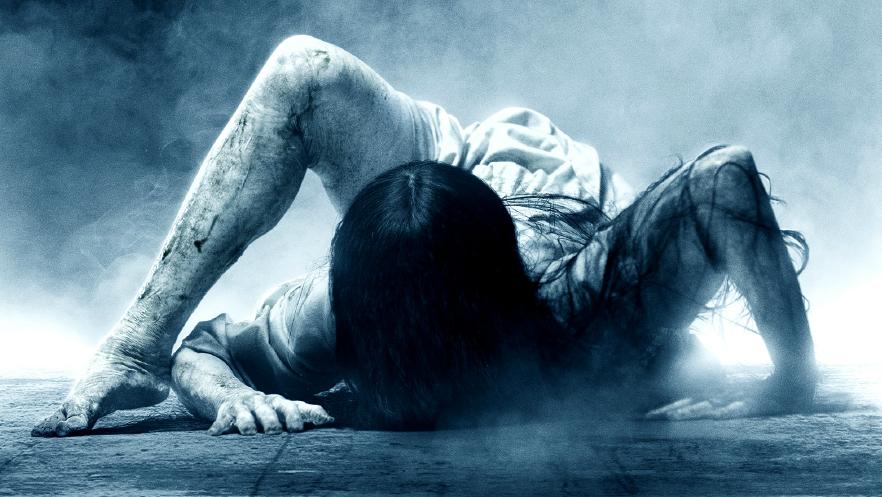
Most of the time when a studio looks to revive or remake an old property it’s a desperate grasp for more money, but I’m willing to give the people behind Rings a little more credit than that. The Ring is about a shared video, and the ways in which we share and consume videos has changed so much in the 15 years since the original came out. Rings exists to carry the franchise into the YouTube era, and it pays off on a lot of the promise offered by the new technology (although not actually YouTube which was strange). Rings is a clever movie, but clever isn’t enough on its own— and unfortunately, clever is all Rings has.
I absolutely adored the use of new technology. There’s a sequence where Samara emerges from a flat screen TV that has fallen face down on the floor that never would have happened 15 years ago and looks amazing. I’m sure the actual technology to do that effect has been around for decades (at least since Thing in The Addams Family I reckon) but it looks like a million bucks and it feels new. While not exactly showing off new technology, there’s a shot right before the credits where a character looks fearfully out a window while it’s raining, and when the lightning lights up the window it becomes the well shot from the cursed tape and that was my favorite shot of the whole film. Again, there are good ideas here through the haze of mediocre filmmaking.
The story is convoluted, and while it contains interesting ideas it ends up right back where every other Ring movie has been. We start out with this interesting idea about studying the tape as a scientific phenomenon with an infrastructure built in a college to keep passing the curse along so it can be studied. This idea is tossed aside at the end of the first act and we get to more exploring the circumstances of Samara’s life in an attempt to break the curse just like we did in The Ring and The Ring Two. There’s a mildly interesting twist, but it all ends up about where one would expect and that’s not even taking in to account that much of the end of the movie is contained in the trailer.
Through all this narrative malaise the entire enterprise is almost saved by two bigger name actors slumming it through Rings. Johnny Galecki is playing a creepy version of his character from The Big Bang Theory and he simply outclasses the array of marginal TV actors and performers I’ve never seen before that he’s put with in this film. It’s not a huge part but Galecki looks like a movie star, which might serve him well if he ever gets tired of sitting around on his giant pile of money after his TV show wraps up. Vincent D’Onofrio is given the most leeway by the script and he turns in a powerful performance. D’Onofrio is capable of switching from unassuming to terribly menacing in the blink of an eye. It’s almost like he never stopped playing Wilson Fisk; he’s the best thing about the film even if his mere presence feels like a bit of a spoiler the first time you see him.
We have to be willing to accept that just about half of movies will be below average, and Rings is certainly in that half, but that that effort separates the mundane from the awful. Rings isn’t a good movie, perhaps because the two lead actors are amazingly boring, but it’s trying. It knows what it has to add to the mythos and it tries to weave those additions seamlessly in to the established formula. The result is a bland retread, but one with moments and performances that will endure— hopefully as inspiration for a better movie down the road.
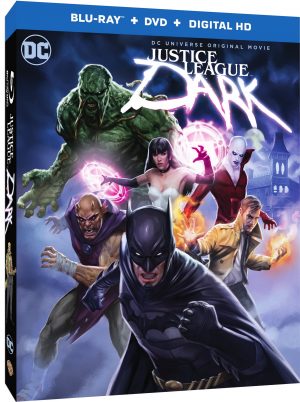 The concept of the DC Comics’ mystical characters gathering to combat occult evil always sounds good but of course, execution is everything. When it was done sparingly, as in Swamp Thing #50, it was quite effective. As an ongoing series, it proved tough to manage since each player was plucked from a title that had a fairly unique look and feel.
The concept of the DC Comics’ mystical characters gathering to combat occult evil always sounds good but of course, execution is everything. When it was done sparingly, as in Swamp Thing #50, it was quite effective. As an ongoing series, it proved tough to manage since each player was plucked from a title that had a fairly unique look and feel.
That said, the newly released animated Justice League Dark film is incredibly entertaining and certainly a cut above the last half-dozen releases. From a story by JLD writer J.M. DeMatteis and Ernie Altbacker, Altbacker’s script shifts the super-heroic DC Universe to supernatural threats that Superman (Jerry O’Connell), Wonder Woman (Rosario Dawson), Green Lantern (Roger Cross) and the others are less equipped to handle. Altbacker is no stranger to heroes and magicians with credits including Spooksville and Green Lantern: The Animated Series and he does a fine job weaving the various threads.
A series of disconnected people around America and then the world think they are seeing demons and a puzzled JLA feels a bit out of their depths. Batman (Jason O’Mara), the logical character to bridge the worlds, is at first skeptical until Deadman (Nicholas Turturro) arrives to possess him and insist he seek out John Constantine (Matt Ryan). To find the Brit, he reconnects with his old friend Zatanna (Camilla Luddington) and from there, the path takes them to Constantine, living in the House of Mystery. Along the way, they collect Jason Blood (Ray Chase), which means we get plenty of doggerel from his counterpart Etrigan the Demon,
Thankfully, the story pauses now and then to give us brief origins which will certainly help introduce these lesser known players to a wider audience.
To locate the cause of the supernatural infestation, Constantine once again uses and abuses friends in trademark fashion. There’s a nice exchange when he must summon Swamp Thing (Roger Cross) for help.
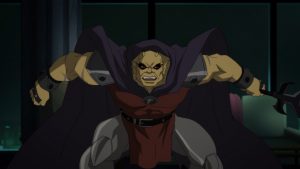 The DC Animated Universe differs sharply from the DC Universe and Cinematic Universe not just in how characters look but also their back stories. The biggest change here is Black Orchid (Colleen Villard), now a spirit protecting the House of Mystery’s artifacts. There’s another substantive change at the end which I won’t mention.
The DC Animated Universe differs sharply from the DC Universe and Cinematic Universe not just in how characters look but also their back stories. The biggest change here is Black Orchid (Colleen Villard), now a spirit protecting the House of Mystery’s artifacts. There’s another substantive change at the end which I won’t mention.
Amped up beyond anything we’ve seen in the comics is Felix Faust (Enrico Colantoni), who seems super-charged as he magically duels the entire team. Later we get an almost unrecognizable Doctor Destiny, here a centuries-old being called only Destiny (Alfred Molina).
The movie moves along at a lovely clip and director Jay Oliva excels with the magic battles, refreshed after growing a tad tiresome of the superhero fights. He brings a nice moody look and feel to the entire production which is most welcome.
Vocally, the cast is strong, of course, and the banter between Luddington (Grey’s Anatomy) and Ryan (live-action’s Constantine) is a highlight.
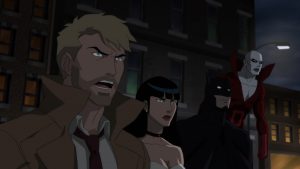 The two-disc gift set comes with a Constantine figurine. Special features on the Blu-ray include an enticing look at this spring’s Teen Titans: The Judas Contract, also from Altbacker. There’s a very nice featurette on The Story of Swamp Thing, featuring cocreator Len Wein and artist Kelley Jones address the creature’s origins and the stunning art from cocreator Bernie Wrightson. There are a series of short, almost pointless, Did You Know?s including Constantine origin, Color of Magic, Black Orchid, and Deadman. A 2016 NY Comic Con Panel is included. Finally, From the DC Vault offers up Batman: The Brave and the Bold, “Dawn of the Dead Man!” and Batman: The Brave and the Bold, “Trials of the Demon!”
The two-disc gift set comes with a Constantine figurine. Special features on the Blu-ray include an enticing look at this spring’s Teen Titans: The Judas Contract, also from Altbacker. There’s a very nice featurette on The Story of Swamp Thing, featuring cocreator Len Wein and artist Kelley Jones address the creature’s origins and the stunning art from cocreator Bernie Wrightson. There are a series of short, almost pointless, Did You Know?s including Constantine origin, Color of Magic, Black Orchid, and Deadman. A 2016 NY Comic Con Panel is included. Finally, From the DC Vault offers up Batman: The Brave and the Bold, “Dawn of the Dead Man!” and Batman: The Brave and the Bold, “Trials of the Demon!”
This past week was quite busy. President Trump pushed back against a “so-called” judge, Melissa McCarthy nailed Sean Spicer on SNL, the Patriots pulled off a record-breaking upset that would have never happened if they were playing the Giants, and it was announced that Aspen Comics would be creating new comic with Scott Lobdell writing a black trans woman titled No World. As much as I’d like to hit on all of these topics, I’m going to focus on No World.
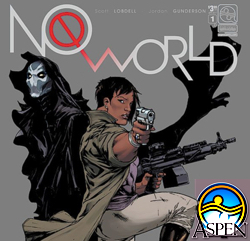 So let’s get into it. Aspen’s new comic is a team book. It will have characters from Soulfire, Executive Assistant, Dellec, as well as some new characters. Lobdell described one of the new characters as “Former NFL. 6’5. 250lbs. She’s here. She’s trans. She’s gonna kick evil’s ass!” You can see that Tweet here. We still don’t have a name or much of a background to this character outside of her being a former NFL player, but we have some information we can start examining.
So let’s get into it. Aspen’s new comic is a team book. It will have characters from Soulfire, Executive Assistant, Dellec, as well as some new characters. Lobdell described one of the new characters as “Former NFL. 6’5. 250lbs. She’s here. She’s trans. She’s gonna kick evil’s ass!” You can see that Tweet here. We still don’t have a name or much of a background to this character outside of her being a former NFL player, but we have some information we can start examining.
Let’s start with former NFL player bit. When we’re dealing with a trans character and one of the only bits of information we get on them is about something from before they came out, that raises a few red flags. There’s a concern that when cis writers tackle trans characters, that there is an unnecessary focus on transitioning. Take a look at Alters where the character of Chalice is in the process of transitioning and we see her as her Charlie persona about as much as we see her as Chalice. If you look at trans writers like Rachel Pollack and Mags Visaggio, we see kick ass trans women without ever having to see them prior to their transition, hearing them go by their dead name or even knowing about it, and so forth. Unfortunately with her being a former NFL player we are likely here this character’s dead name multiple times. Sometimes cis writers do a good job with this like when Gail Simone had Alysia Yeoh come out as trans, but that doesn’t mean we shouldn’t approach this with some caution.
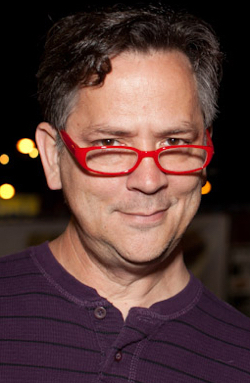 Moving on to her being 6’5 and 250 lbs, Scott follows that up using the hashtags #gnc, short for gender nonconforming, and #nonbinary. There is also an image of her that Scott shared with the line “passing is for footballs.” These elements are a bit more interesting. Trans characters in comics are mostly white and mostly attempt to pass. Trans characters of color, particularly black trans women, have been very rarely seen in comics and are also easily of the most victimized members of the queer community. This type of representation is sorely needed.
Moving on to her being 6’5 and 250 lbs, Scott follows that up using the hashtags #gnc, short for gender nonconforming, and #nonbinary. There is also an image of her that Scott shared with the line “passing is for footballs.” These elements are a bit more interesting. Trans characters in comics are mostly white and mostly attempt to pass. Trans characters of color, particularly black trans women, have been very rarely seen in comics and are also easily of the most victimized members of the queer community. This type of representation is sorely needed.
It’s also important to note that some people who consider themselves gender nonconforming or nonbinary may be okay with she/her/herself as well as they/them/theirself, so that could end up being just fine.
Scott Lobdell is no stranger to creating a trans character. He created Suzie Su for Red Hood and the Outlaws. This particular trans character was a very unflattering portrayal, a villain, and someone who was more than willing to murder children to get what she wants. It’s worth noting this was his only other portrayal of a trans character in comics that has made it into print and should at very least cause many to wait and see how No World plays out before praising or condemning this representation.
Unlike comics like Alters, No World has no trans representation in its creative team, which seems to be mostly straight cis white men. That’s not inherently a bad thing, but when tackling a character like this one it’s not necessarily comforting either.
Scott has at least stated on February 3rd that he’s consulting with some members of the trans community. You can see that Tweet here. He talks of a few trans friends that helped him as well, including Shakina who plays Lola on Difficult People. One thing you may notice following that link, at least at the time I wrote this, is that Scott Lobdell has yet to responded to Mags Visaggio’s questions and offering to consult with Scott on this character.
For the most part, I’m concerned about how this comic will play out. While there is evidence of talking with some trans women, there isn’t any evidence of Scott Lobdell consulting with people who are gender nonconforming or nonbinary. It seems this will also be a story that involves dealing with the characters life pre-transition. It’s also very possible that this character will not even be featured heavily in this series; it’s a team book.
I do hope that Scott will use his position in comics to help trans creators here on out. For example, Neil Gaiman wrote a trans character in The Sandman which helped get Rachel Pollack and Caitlin R. Kiernan noticed by DC Comics, which in turn lead to them working for thay company for years. While the character has been reexamined and there is valid criticism, by helping trans creators get noticed it shows that Neil genuinely cares about the trans community. Paul Jenkins on Alters got Tamra Bonvillain work on that title.
No matter how this particular title develops, I hope Scott Lobdell’s interest in the trans community goes beyond No World and that we’ll see him help lift up this group of comics creators that are too often overlooked.
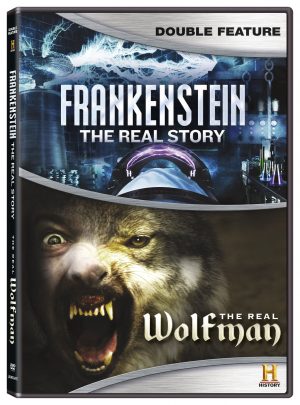 The History Channel has occasionally explored the roots of the monsters that thrilled and chilled our childhood and Lionsgate Home Entertainment has dutifully released them on disc every now and then. Coming Tuesday is a nice little double feature package collecting the previously released Frankenstein: The Real Story and The Real Wolfman on a single standard DVD for the bargain price of $12.98.
The History Channel has occasionally explored the roots of the monsters that thrilled and chilled our childhood and Lionsgate Home Entertainment has dutifully released them on disc every now and then. Coming Tuesday is a nice little double feature package collecting the previously released Frankenstein: The Real Story and The Real Wolfman on a single standard DVD for the bargain price of $12.98.
While overwrought and overly dramatic with some cheesy music and effects, both creations are worth a look if only because it gives us a chance to look at things in context.
We begin with three pieces exploring Frankenstein and his monster. Mary Wollstonecraft Shelley’s novel, as many know, was written as a result of a ghost story contest among her literary peers. What the In Search of the Real Frankenstein does is explore the quickly evolving world of science in the early nineteenth century. Scientists had used electricity to animate animal limbs and others tried shocking humans as well. And while touring Europe with Percy Shelley, she is likely to have heard about Konrad Dippel, who conducted unsavory experiments in the real Frankenstein castle. All of which acts are prelude to the second piece, Frankenstein, which is more biographical about Shelley herself. Her scandalous affair with Percy, who left his pregnant wife to tour with her, and life after his death are nicely covered along with the novel itself, which first appeared without her byline. She finally affixed her name to it five years later for the second edition.
The final piece is It’s Alive! The True Story of Frankenstein, narrated by Roger Moore (one wonders why he was chosen). Here, the many stage and screen adaptations of her work, are examined and I am pleased the Hammer films get their due so the focus isn’t just on Universal’s output. There are nice interviews with Mel Brooks, Gene Wilder, special effects wizard Rick Baker, film historian David Skal, Sara Karloff, Kenneth Branagh, and, Peter Bogdanovich. While the most familiar of the three, it is satisfying.
What most fans may be less aware of is covered in The Real Wolfman, a 90-minute exploration of the thing called Gevaudan that is credited with killing 100 people in France at the end of the eighteenth century. Similar to Ghost Hunters, the film features George Deucher, a retired policeman and criminal profiler, and Ken Gerhard, a crypto-zoologist as they journey to France in search of the truth behind the legend. They come off as somewhat clueless and at times erratic as they interview historians and descendants of the people who were there during the attacks. Most interesting is the story of Jean Chastel, credited with ending the threat, possibly using silver bullets he made and then had blessed by a priest. Some coverage is devoted to the history of werewolves, which puts Gevaudan into perspective. The reenactments are nicely done and add a quality touch to the production.
This disc is a representation of the previous releases and appears in 1.33:1 standard ratio with Dolby digital 2 channel audio. As a result, everything is perfectly acceptable for home viewing.
There are no extras presented with this fun double-feature.
I watched the second episode of Riverdale mainly because there wasn’t anything else on that interested me, and secondly because I wanted to give it another chance. I admit to having a negative disposition towards the show – the premiere, if you recall, elicited an unenthusiastic response from me. So let me start with what I liked…
Ummm…Hmmm…
Nope. Sorry. Aside from the twisting of an American icon into something dark and twisted – hey, did Zack Snyder have anything to do with the production? – small things just kept aggravating me. Like Archie’s hair bothers me. Hey, for 76 years (the first appearance of Archie, Betty, and Veronica was in Pep Comics, cover-dated December 1941) the guy has been a true “carrot-top,” his coloring closer to Damien Lewis (Homeland, Billions), but Mr. Apa’s hair – and I grant you, the kid has some terrific head of hair on him – is a dark chestnut, as if a henna rinse was applied to his brunette locks… and not all of it took.
Am I being silly? Yeah, perhaps. After all, the original Barry Allen, a.k.a., the Flash, has blonde hair and blue eyes, and Grant Gustin, who plays him on TV, has light brown hair and eyes. But Mr. Gustin and his supporting characters are so well written, the show is so engaging, that holding fast and true to their comic book driver license pictures and ID’s becomes secondary to the viewer – at least this viewer.
And although Lili Reinhart and Camilla Mendes do honor the looks of their four-color progenitors (Betty Cooper and Veronica Lodge, respectively), I’m not feeling them. In my mind, I keep substituting Kristen Bell and Charisma Carpenter (as they were back in the day on those other teenagers-in-high-school-hell) for Ms. Reinhart and Ms. Mendes. This is not to impugn the talent of either of the later two; there just hasn’t been any there yet to separate them from any other starlet.
As for Case Cott’s Kevin Keller – can he do anything else besides drool over some other male character? Sheesh, how one-dimensional can you get? Okay, we get it, he’s gay. Jesus, enough already with the tokenism. (Tell us how you really feel, Mindy.)
The only character I find intriguing at all is Forsyth Pendleton Jones, a.k.a. Jughead, which is ironic, because he has always been the least interesting character to me in the comics. Played by Cole Sprouse, Jughead is the guy just standing off from the center of activity, the one who marches to the beat of a different drum, the neo-beatnik, the observer. He’s the type girls’ parents really warn them about (as opposed to Betty’s mother cautioning her about Archie). Im-not-so-ho, if the show is to succeed, it needs to hitch its wagon to Jughead Jones.
Right now, the Super Bowl pregame show is on. I am really, really, really rootin’ for the Atlanta Falcons, if only to wipe that smug smile off of Tom Brady. I know the guy is one of the best quarterbacks to ever play the game, but there’s always been something about him that irks me, and always has. And it doesn’t have anything to do with Deflate-gate, or even Brady’s support of Il Trumpci. (Yeah, “Make America Great Again,” you poor, poor multi-millionaire.) So, Go, Falcons!!!
Great commercial on right now with “Oh, My!” George Takei. (I think it was for Pizza Hut.) The other commercial I want to see is the Stranger Things Season 2 teaser trailer.
There’s another premiere following tonight’s game. I read the New York Times review, and here’s piece of it, by Neil Genzlinger:
“Until the Trump presidency became a reality, the main order of business in any review of 24: Legacy would have been to assess whether the franchise is still viable without Jack Bauer, Kiefer Sutherland’s memorable counterterrorism operative, as its lead character. Now, though, and especially given the events of the past week, it’s the show’s chosen villains, not its hero, who demand attention.
“That’s because a good number of them speak in foreign accents, and some embody President Trump’s bogyman of the moment, the radical Muslim terrorist.
“The premiere was filmed back when it seemed unlikely that Mr. Trump would be elected – it was screened in New York on November 7 – but the opening moments play as if they were scripted to support the immigration restrictions he imposed last week. The series grows considerably more layered as it goes along, with the panoply of villains encompassing a variety of demographics, yet the choice of a bin Laden surrogate as the starting point is sure to reignite the debate over the demonization of Muslims that “24” has encountered before.”
And Coca-Cola just had a beautiful commercial – men, women, and children of different ethnicities, religions, and colors singing America the Beautiful.
If that bastard in the White House and his band of malevolent goons are watching –
Have a Coke on me.
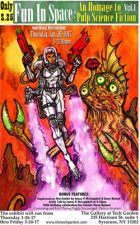
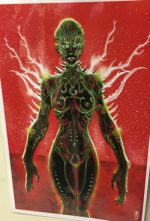 Science Fiction is a term that means a lot of different things to a lot of different fans. When I was kid I thought it kind of meant Star Trek and Lost in Space, Bradbury books and the Twilight Zone episodes that included aliens. Of course, it’s so much bigger than that. There are subgenres and all kinds of slivers of fandoms that are populated with bazillions of fans. And Star Wars, of course, has just about transcended the entire genre and become its own thing.
Science Fiction is a term that means a lot of different things to a lot of different fans. When I was kid I thought it kind of meant Star Trek and Lost in Space, Bradbury books and the Twilight Zone episodes that included aliens. Of course, it’s so much bigger than that. There are subgenres and all kinds of slivers of fandoms that are populated with bazillions of fans. And Star Wars, of course, has just about transcended the entire genre and become its own thing.
So it’s was all the more interesting that a local art exhibit chose to focus on the earliest incarnation of science fiction. It’s called “Fun in Space: An Homage to Pulp Science Fiction.”
Pulp Science Fiction is cheesy and brilliant all at the same time. Pulps often sported lurid and garish covers aimed at adolescent males. On the other hand, so many authors, like Ray Bradbury, H.P. Lovecraft, Edgar Rice Burroughs and Robert Heinlein started telling their endearing and enduring tales in the pulps.

 Lurid and garish are two of my favorite adjectives, so it’s natural that I just love old pulp covers. They’re silly, naïve and needlessly sexualized. They are also lovely and skillfully rendered, all with an intense sense of urgency and excitement.
Lurid and garish are two of my favorite adjectives, so it’s natural that I just love old pulp covers. They’re silly, naïve and needlessly sexualized. They are also lovely and skillfully rendered, all with an intense sense of urgency and excitement.
The show’s curator is Steve Nyland. He’s enthusiastic and focused, able to make something like this art show happen and able to convin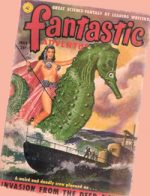 ce all the powers that be that it should happen. Nyland told me about how he developed a love for pulp science fiction stories as a kid and it’s never left him.
ce all the powers that be that it should happen. Nyland told me about how he developed a love for pulp science fiction stories as a kid and it’s never left him.
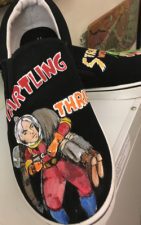 One of my favorites pulps has been an old issue of Fantastic Adventures that showcases the story “Invasion from the Deep” by Paul W. Fairman. The cover shows a submarine crew astonished as a giant – and I mean giant – undersea princess is bursting through the waves riding an equally giant seahorse.
One of my favorites pulps has been an old issue of Fantastic Adventures that showcases the story “Invasion from the Deep” by Paul W. Fairman. The cover shows a submarine crew astonished as a giant – and I mean giant – undersea princess is bursting through the waves riding an equally giant seahorse.
At the heart of it all – this “Fun in Space” exhibit channeled that frenetic energy. My favorite piece is a recreation of an old issue of Fantastic Adventures featuring the unforgettable story, the Justice of Tor. (Well, OK, that story is actually completely forgettable, but the cover is gorgeous.)
There is so much great artwork here that channels the charm of old science fiction, especially one evoking an Al Feldstein EC Comics cover and another with mash-up of iconic sci fi characters. I was nice to see Spock dancing with Princess Leia.
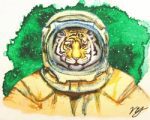
 And cosplay is everywhere! Even at opening night for a Science Fiction art exhibit in downtown Syracuse. On hand were clever cosplayers, celebrating the many aspects of the genre.
And cosplay is everywhere! Even at opening night for a Science Fiction art exhibit in downtown Syracuse. On hand were clever cosplayers, celebrating the many aspects of the genre.
The contributing artists stretched a bit too – with some cool sculptures and painted sneakers and furniture.
The gallery is part of a business incubator in downtown Syracuse New York called the Tech Garden. It makes all the sense in the world that a business building that attracts dreamers and non-traditionalists would host an art show that attracts dreamers and non-traditionalists.
I wish I could refrain from corny puns and not write that the opening was “out of this world,” but it was a fun, upbeat celebration by a passionate bunch of talented artists for like-minded geeks.
My favorite superhero TV show these days is The Flash. Heck, it may be my favorite TV show period. Grant Gustin is doing a great job as Barry Allen/The Flash and the stories have wonderful “Easter eggs” for those who know DC continuity. One of the best is casting John Wesley Shipp, who played Barry/Flash in the earlier TV incarnation of The Flash, is in this version first as Barry’s dad and now as Jay Garrick, the Flash of Earth-2.
What also is great is the supporting cast on the show. On The Flash, they’ve even increased by one to include Tom Fenton (perhaps best known as Draco Malfoy in the Harry Potter films) as Barry’s “frenemy”. He’s also joined “Team Flash” as it’s called, even on the show.
This is where the TV versions of the Flash (and the other superheroes) differs from the comics. In the comics, the hero is usually a lone wolf type; others in his circle don’t know his/her double identity and keeping that secret is considered vital. On TV, however, the superhero needs a circle of friends to help them function. Just as it’s been said that it takes a village to raise a child, on TV shows it takes a team to make a superhero. Actually, more than a team – the supporting cast acts a lot more like a family.
This isn’t true just on The Flash – it also holds true on Supergirl and Arrow as well. Legends Of Tomorrow is a team, as is Agents of S.H.I.E.L.D. There are good reasons for this – any TV show needs a good supporting cast for the main character to act with (or against). Those interactions provide drama, comedy, their own storylines and, with a continuing series, that’s necessary. It also lets the lead not be in every scene which can really burn out an actor. As an audience, we invest emotionally not only with the lead character but with the supporting cast. (I’ll be honest – on Arrow I’m not all that invested in the lead actor; often it is the support characters that I like better, especially Felicity.)
On Flash, for example, they have a wonderful conceit; there’s the character of Dr. Harrison Wells, played by Tom Cavenaugh. He’s the same character in each of the three seasons so far but he’s also very different as each season we get a new Harrison Wells from a different dimension. In the first season, he was a villain, in the second season he was something of an asshole, and in the current season he’s a bit of a goof. That must be a lot of fun for Cavenaugh and it creates a different dynamic with the team for each season.
Some comics have family – the Fantastic Four functioned best when the writers and editors realized the FF were not just another team; they really were family. Also, I remember when DC would publish large giant comics for the “Superman Family” or the “Batman Family.” Superman, for example, had his best friend, his girl friend, his cousin, his dog, other super-pets, and the kids from down the timeline, a.k.a. the Legion of Super-heroes. However, it’s not quite the same thing as the TV shows. There’s a central location where they all meet and work out of – S.T.A.R. labs, the Arrow cave (or whatever they’re calling it), the DEO HQ, the Waverider. Home.
Needless to say, the TV shows and the comics are different animals, each with their own needs. It costs less to produce the comic books and the special effects and locations are limited only by what the artist can draw. Yet, I will admit that I’ve come to prefer the TV versions in most cases. I think that, overall, they’re a bit better thought out. OTOH, they don’t have to justify decades of continuity; they’re re-interpreting and re-inventing everything. There’s more freedom in that.
It’s good to keep in mind that no man is an island.
No metahuman is, either.